Page 103 of 525
Door Latches
Check for positive closing, latching, and locking.
Fluid Leaks
Check area under vehicle after overnight parking for fuel,
engine coolant, oil, or other fluid leaks. Also, if gasoline
fumes are detected or if fuel, power steering fluid, or
brake fluid leaks are suspected, the cause should be
located and corrected immediately.
2
THINGS TO KNOW BEFORE STARTING YOUR VEHICLE 101
Page 107 of 525
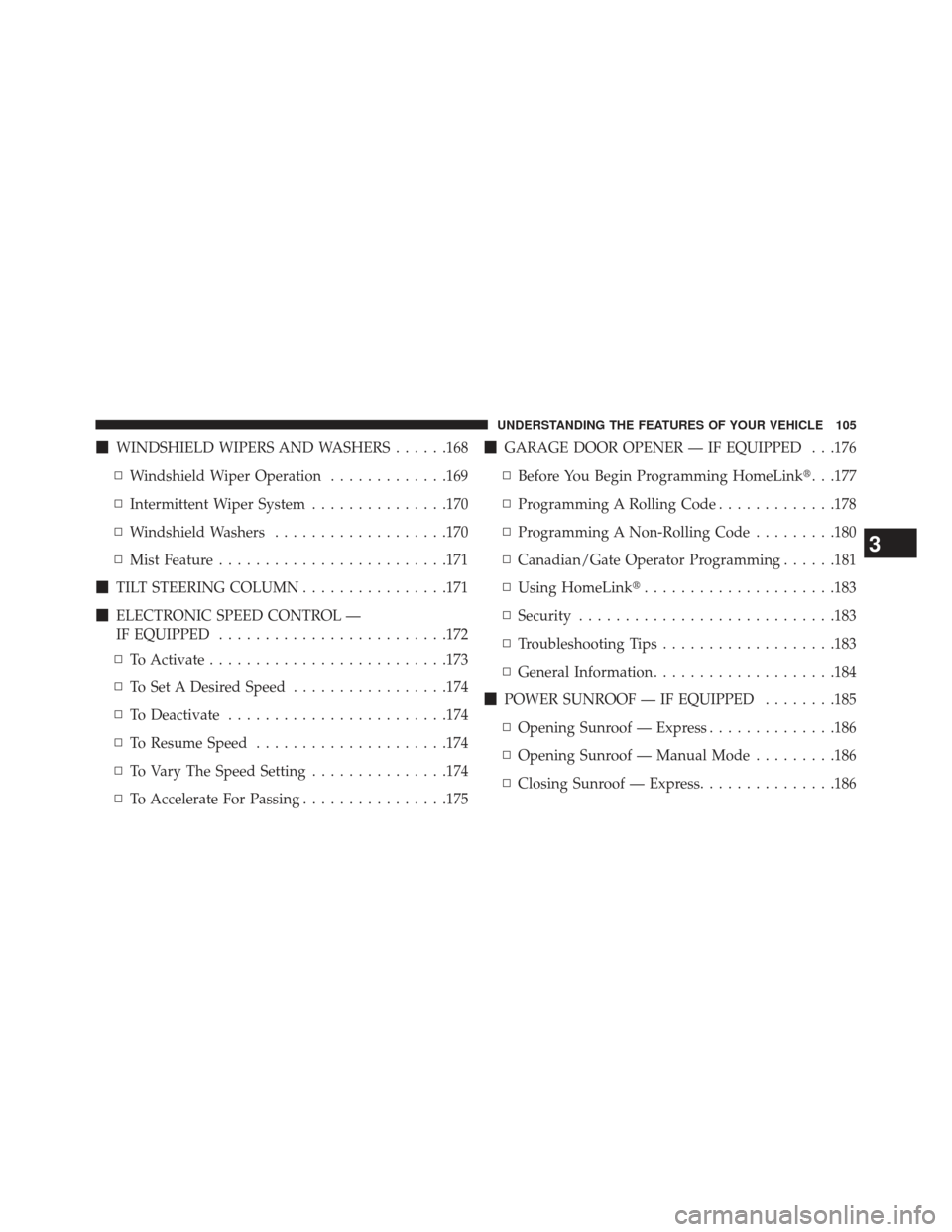
�WINDSHIELD WIPERS AND WASHERS ......168
▫ Windshield Wiper Operation .............169
▫ Intermittent Wiper System ...............170
▫ Windshield Washers ...................170
▫ Mist Feature ........................ .171
� TILT STEERING COLUMN ................171
� ELECTRONIC SPEED CONTROL —
IF EQUIPPED ........................ .172
▫ To Activate ......................... .173
▫ To Set A Desired Speed .................174
▫ To Deactivate ....................... .174
▫ To Resume Speed .....................174
▫ To Vary The Speed Setting ...............174
▫ To Accelerate For Passing ................175 �
GARAGE DOOR OPENER — IF EQUIPPED . . .176
▫ Before You Begin Programming HomeLink� . . .177
▫ Programming A Rolling Code .............178
▫ Programming A Non-Rolling Code .........180
▫ Canadian/Gate Operator Programming ......181
▫ Using HomeLink� .....................183
▫ Security ........................... .183
▫ Troubleshooting Tips ...................183
▫ General Information ....................184
� POWER SUNROOF — IF EQUIPPED ........185
▫ Opening Sunroof — Express ..............186
▫ Opening Sunroof — Manual Mode .........186
▫ Closing Sunroof — Express ...............186
3
UNDERSTANDING THE FEATURES OF YOUR VEHICLE 105
Page 205 of 525
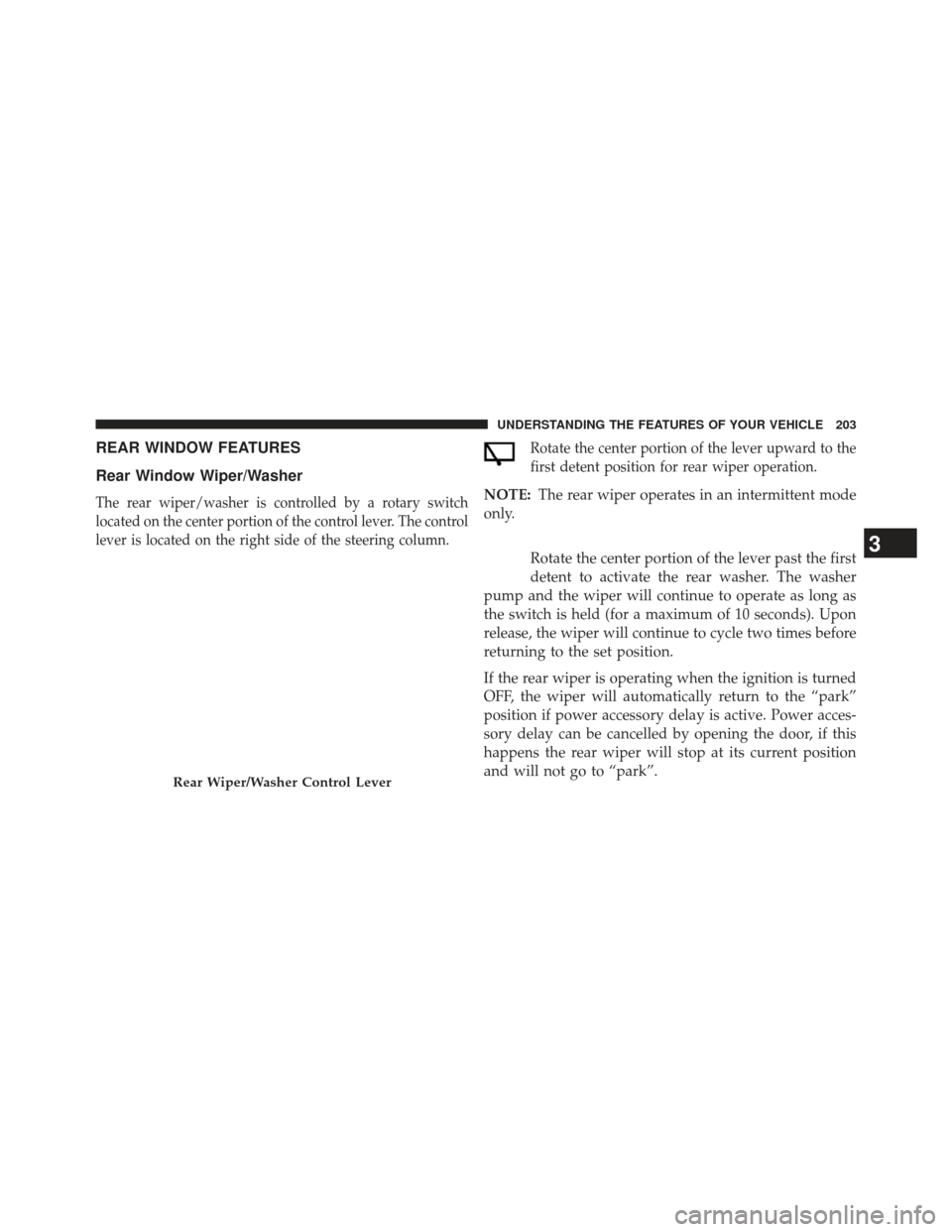
REAR WINDOW FEATURES
Rear Window Wiper/Washer
The rear wiper/washer is controlled by a rotary switch
located on the center portion of the control lever. The control
lever is located on the right side of the steering column.
Rotate the center portion of the lever upward to the
first detent position for rear wiper operation.
NOTE:The rear wiper operates in an intermittent mode
only.
Rotate the center portion of the lever past the first
detent to activate the rear washer. The washer
pump and the wiper will continue to operate as long as
the switch is held (for a maximum of 10 seconds). Upon
release, the wiper will continue to cycle two times before
returning to the set position.
If the rear wiper is operating when the ignition is turned
OFF, the wiper will automatically return to the “park”
position if power accessory delay is active. Power acces-
sory delay can be cancelled by opening the door, if this
happens the rear wiper will stop at its current position
and will not go to “park”.
Rear Wiper/Washer Control Lever
3
UNDERSTANDING THE FEATURES OF YOUR VEHICLE 203
Page 312 of 525
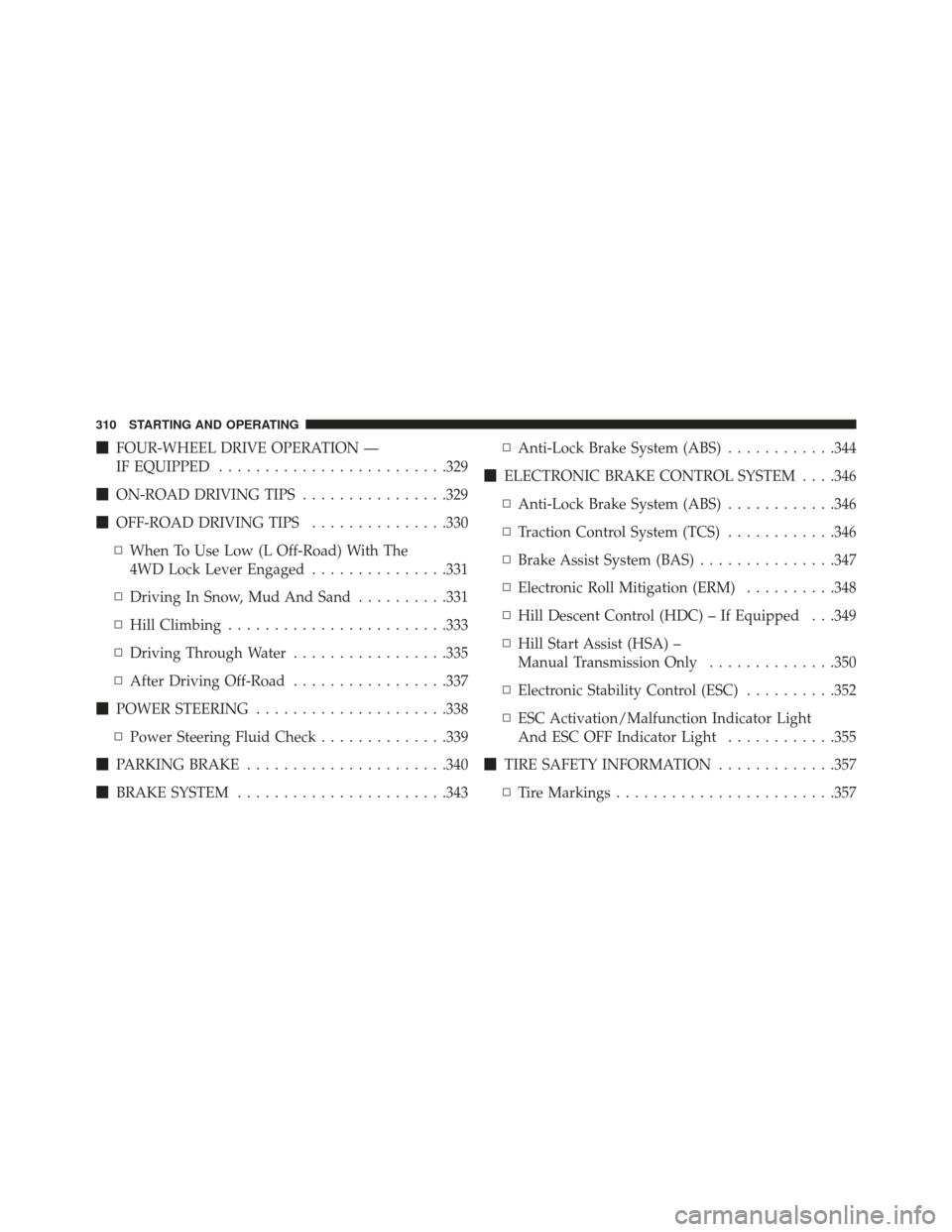
�FOUR-WHEEL DRIVE OPERATION —
IF EQUIPPED ........................ .329
� ON-ROAD DRIVING TIPS ................329
� OFF-ROAD DRIVING TIPS ...............330
▫ When To Use Low (L Off-Road) With The
4WD Lock Lever Engaged ...............331
▫ Driving In Snow, Mud And Sand ..........331
▫ Hill Climbing ....................... .333
▫ Driving Through Water .................335
▫ After Driving Off-Road .................337
� POWER STEERING .....................338
▫ Power Steering Fluid Check ..............339
� PARKING BRAKE ..................... .340
� BRAKE SYSTEM ...................... .343▫
Anti-Lock Brake System (ABS) ............344
� ELECTRONIC BRAKE CONTROL SYSTEM . . . .346
▫ Anti-Lock Brake System (ABS) ............346
▫ Traction Control System (TCS) ............346
▫ Brake Assist System (BAS) ...............347
▫ Electronic Roll Mitigation (ERM) ..........348
▫ Hill Descent Control (HDC) – If Equipped . . .349
▫ Hill Start Assist (HSA) –
Manual Transmission Only ..............350
▫ Electronic Stability Control (ESC) ..........352
▫ ESC Activation/Malfunction Indicator Light
And ESC OFF Indicator Light ............355
� TIRE SAFETY INFORMATION .............357
▫ Tire Markings ....................... .357
310 STARTING AND OPERATING
Page 315 of 525
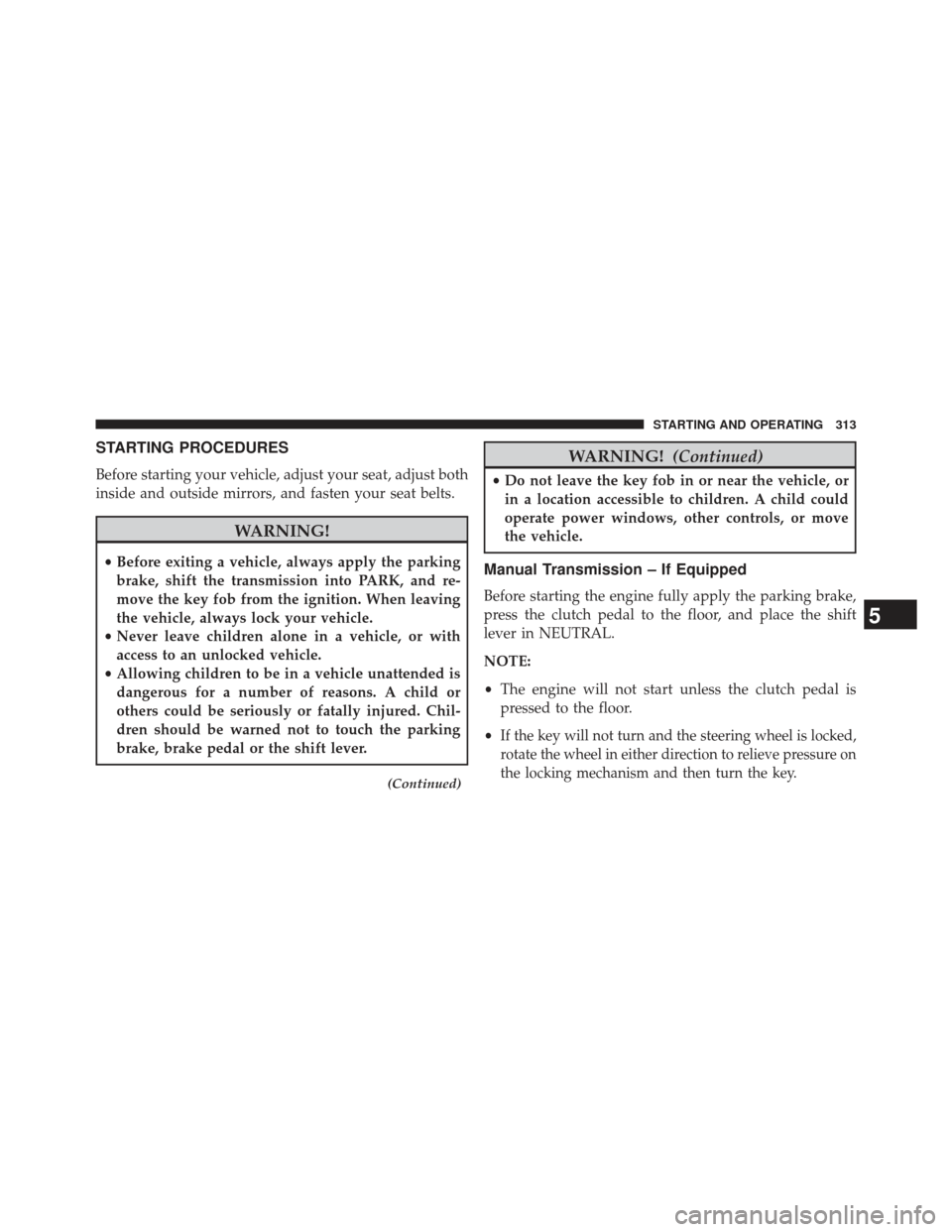
STARTING PROCEDURES
Before starting your vehicle, adjust your seat, adjust both
inside and outside mirrors, and fasten your seat belts.
WARNING!
•Before exiting a vehicle, always apply the parking
brake, shift the transmission into PARK, and re-
move the key fob from the ignition. When leaving
the vehicle, always lock your vehicle.
• Never leave children alone in a vehicle, or with
access to an unlocked vehicle.
• Allowing children to be in a vehicle unattended is
dangerous for a number of reasons. A child or
others could be seriously or fatally injured. Chil-
dren should be warned not to touch the parking
brake, brake pedal or the shift lever.
(Continued)
WARNING! (Continued)
•Do not leave the key fob in or near the vehicle, or
in a location accessible to children. A child could
operate power windows, other controls, or move
the vehicle.
Manual Transmission – If Equipped
Before starting the engine fully apply the parking brake,
press the clutch pedal to the floor, and place the shift
lever in NEUTRAL.
NOTE:
• The engine will not start unless the clutch pedal is
pressed to the floor.
•
If the key will not turn and the steering wheel is locked,
rotate the wheel in either direction to relieve pressure on
the locking mechanism and then turn the key.
5
STARTING AND OPERATING 313
Page 333 of 525
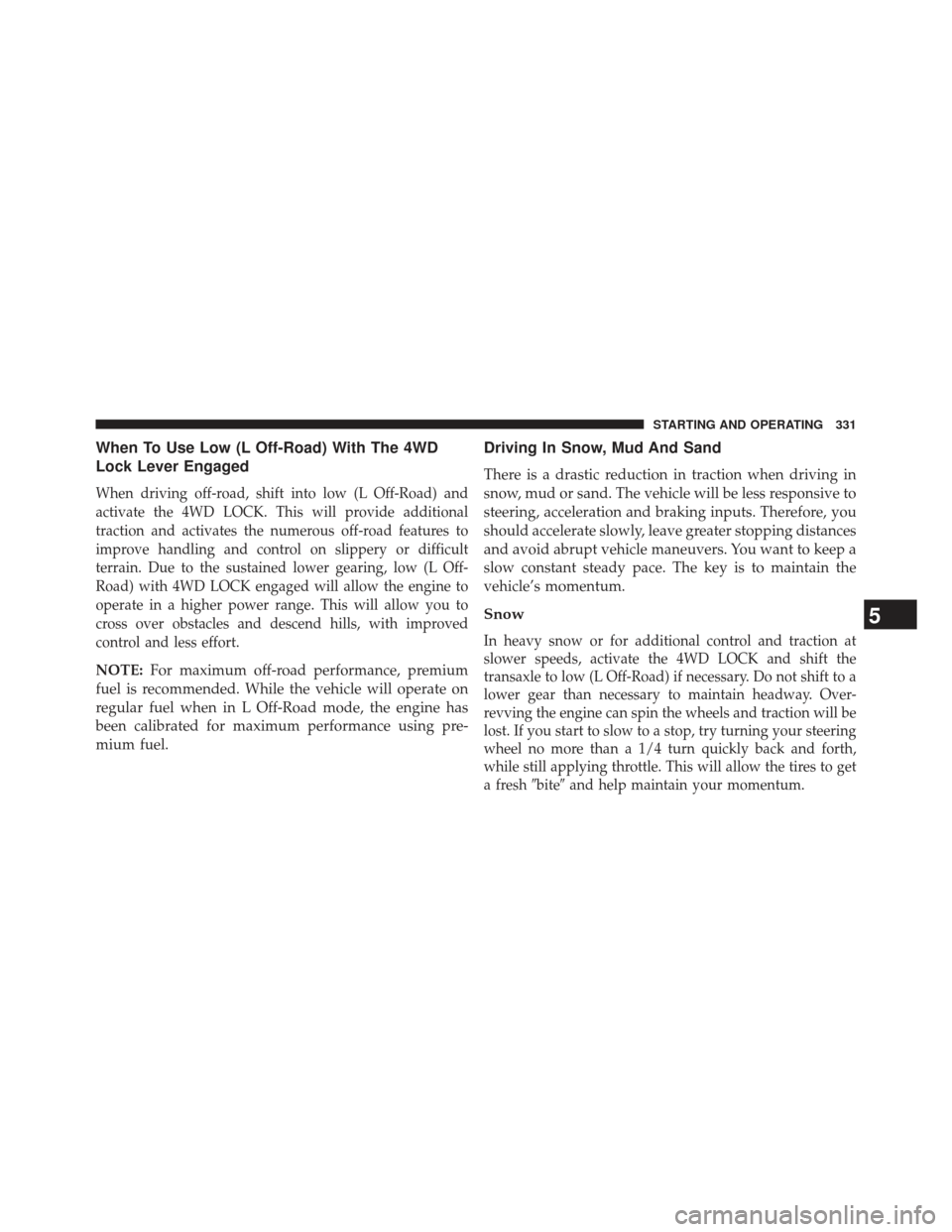
When To Use Low (L Off-Road) With The 4WD
Lock Lever Engaged
When driving off-road, shift into low (L Off-Road) and
activate the 4WD LOCK. This will provide additional
traction and activates the numerous off-road features to
improve handling and control on slippery or difficult
terrain. Due to the sustained lower gearing, low (L Off-
Road) with 4WD LOCK engaged will allow the engine to
operate in a higher power range. This will allow you to
cross over obstacles and descend hills, with improved
control and less effort.
NOTE:For maximum off-road performance, premium
fuel is recommended. While the vehicle will operate on
regular fuel when in L Off-Road mode, the engine has
been calibrated for maximum performance using pre-
mium fuel.
Driving In Snow, Mud And Sand
There is a drastic reduction in traction when driving in
snow, mud or sand. The vehicle will be less responsive to
steering, acceleration and braking inputs. Therefore, you
should accelerate slowly, leave greater stopping distances
and avoid abrupt vehicle maneuvers. You want to keep a
slow constant steady pace. The key is to maintain the
vehicle’s momentum.
Snow
In heavy snow or for additional control and traction at
slower speeds, activate the 4WD LOCK and shift the
transaxle to low (L Off-Road) if necessary. Do not shift to a
lower gear than necessary to maintain headway. Over-
revving the engine can spin the wheels and traction will be
lost. If you start to slow to a stop, try turning your steering
wheel no more than a 1/4 turn quickly back and forth,
while still applying throttle. This will allow the tires to get
a fresh �bite�and help maintain your momentum.
5
STARTING AND OPERATING 331
Page 340 of 525

•Check threaded fasteners for looseness, particularly on
the chassis, drivetrain components, steering, and sus-
pension. Retighten them, if required, and torque to the
values specified in the Service Manual.
• Check for accumulations of plants or brush. These
things could be a fire hazard. They might hide damage
to fuel lines, brake hoses, axle pinion seals, and
propeller shafts.
• After extended operation in mud, sand, water, or
similar dirty conditions, have the radiator, fan, brake
rotors, wheels, brake linings, and axle yokes inspected
and cleaned as soon as possible.
WARNING!
Abrasive material in any part of the brakes may cause
excessive wear or unpredictable braking. You might
(Continued)
WARNING! (Continued)
not have full braking power when you need it to
prevent a collision. If you have been operating your
vehicle in dirty conditions, get your brakes checked
and cleaned as necessary.
• If you experience unusual vibration after driving in
mud, slush or similar conditions, check the wheels for
impacted material. Impacted material can cause a
wheel imbalance and freeing the wheels of it will
correct the situation.
POWER STEERING
The standard power steering system will give you good
vehicle response and increased ease of maneuverability
in tight spaces. The system will provide mechanical
steering capability if power assist is lost.
338 STARTING AND OPERATING
Page 341 of 525
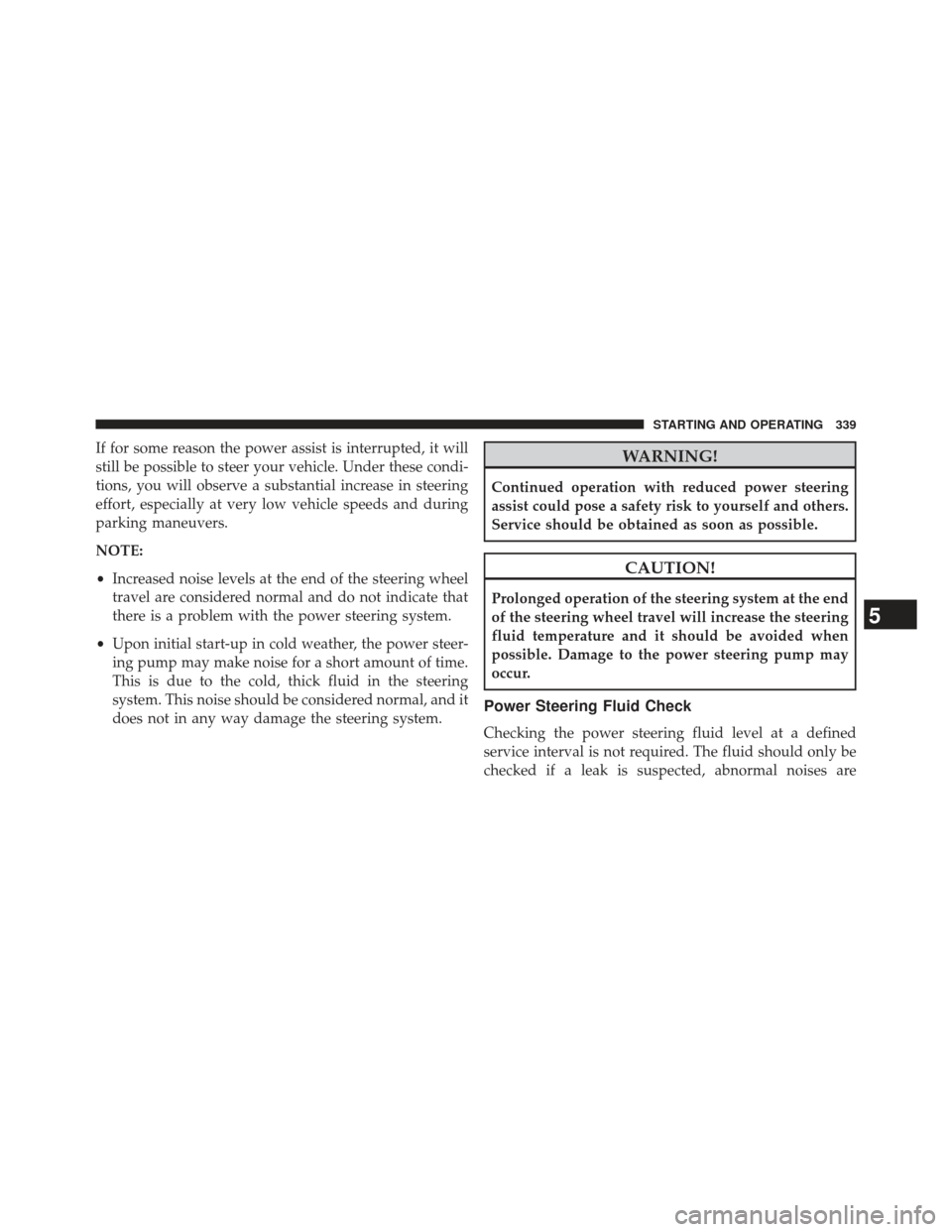
If for some reason the power assist is interrupted, it will
still be possible to steer your vehicle. Under these condi-
tions, you will observe a substantial increase in steering
effort, especially at very low vehicle speeds and during
parking maneuvers.
NOTE:
•Increased noise levels at the end of the steering wheel
travel are considered normal and do not indicate that
there is a problem with the power steering system.
• Upon initial start-up in cold weather, the power steer-
ing pump may make noise for a short amount of time.
This is due to the cold, thick fluid in the steering
system. This noise should be considered normal, and it
does not in any way damage the steering system.WARNING!
Continued operation with reduced power steering
assist could pose a safety risk to yourself and others.
Service should be obtained as soon as possible.
CAUTION!
Prolonged operation of the steering system at the end
of the steering wheel travel will increase the steering
fluid temperature and it should be avoided when
possible. Damage to the power steering pump may
occur.
Power Steering Fluid Check
Checking the power steering fluid level at a defined
service interval is not required. The fluid should only be
checked if a leak is suspected, abnormal noises are
5
STARTING AND OPERATING 339